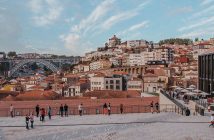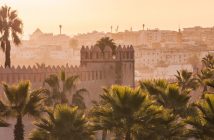‘You don’t know what a leche leche is? Then, my darling, I’m glad we met’, said the waify waitress as she turned on her heel, quickly reappearing with a small caffeinated concoction. Excitedly she introduced me to each of the three layers; the sticky dollop of sweet condensed milk crowned with a shot of strong coffee and topped up with warm, creamy milk. And, with that, she left, raised eyebrow and all.
As my cheeks flushed, I felt a little foolish. But if my inadequate coffee knowledge was to be superseded by anything, it was my nativity of Lanzarote’s raw and rugged beauty. Having visited two decades ago on an unmemorable package tour I presumed that by now the year-round destination would be cluttered with characterless resorts, packed beaches and the odd camel. Yet here I was, the only tourist in the bay, sipping my leche leche like a local in front of the raging Atlantic at an idyllic cafe pulled straight off the whimsical cover of a Katie Fforde novel.
The last week of endless hiking up and down volcanoes and trekking through endless seas of lava and desert had been a revelation. And having left the golden beaches of busy Playa Blanca behind we were now destined for the Monaco of Lanzarote; Puerto Calero. Situated further up the island’s east coast the exclusive yachtie enclave, fringed with a palm-lined promenade, has a pristine marina at its heart.  Alongside its flashy yachts and speedboats, it has a pleasing selection of restaurants, bars, cafes and a handful of designer shops. The perfect retreat for weary feet.
Alongside its flashy yachts and speedboats, it has a pleasing selection of restaurants, bars, cafes and a handful of designer shops. The perfect retreat for weary feet.
The immaculate promenade paves the way for the stylish villas which overlook the tame volcanic coastline of craggy jet-black outcrops and twinkling rock pools. Our home for the week was Villa Estebana; a modern three-bedroom property from the Oliver’s Travels portfolio. Residing ten minutes’ stroll from the marina its sleek glass-heavy design encourages you to take in the shimmying Atlantic at every opportunity. Downstairs the full-size glass wall opens out on to a neat sun terrace complete with a private pool. This window to the ocean floods the living area with light, providing you with a front row seat as the yachts tack and jibe in the wind – a view shared from the master bedroom’s balcony.
With an active week of exploring the island already under our belts, it didn’t take us long to succumb to Puerto Calero’s leisurely pace and balmy outlook. Soon our mornings were spent stargazing with a coffee on the villa’s terrace, watching the darkness gradually fade away as the boats set sail, one by one, beneath the pink bellied clouds which wafted by. When the port’s famed yellow submarine sunk its way out of sight, it was time to head off on our morning hike.
Our daily hikes saw us thrown in to an unworldly array of landscapes; from vast dunes and volcanic craters to vertigo-inspiring ridges, unwavering cliffs and the land of fire’s iconic black sand beaches. It was during our stay at Villa Estebana that we embarked on the longest walk of our stay, starting in the ‘miracle town’ of Yaiza. During the island’s volcanic climax Yaiza’s pretty streets and squares seemed destined for devastation, yet somehow, surrounded by the constant torrents of molten rock that engulfed its neighbours, it survived.

We set off at sunrise, up a steep and surprisingly verdant vale, dotted with wild flowers, where determined locals were managing to grow everything from peppers and onions to tomatoes and vines – impressive given that some parts of the island receive less rainfall than the Sahara. As we climbed (slowly), dog barks and cockerel calls cascaded down the valley to the backing track of rustling palms.
A rough mountainside ascent was rewarded with panoramic vistas of the island’s South coast, taking in El Golfo’s ragged coastline, the pearly Salinas de Janubio salt pans and the busy resort of Playa Blanca, all awaking from their slumber. From afar the resort’s busy streets and whitewashed complexes looked like brilliant white waves crashing against the shore.
Our descent took us across parched terracotta plains and in to the picturesque village of Las Breñas. Nestled in the foothills of the Los Ajaches mountains the village exudes a free-spiritedness, with quirky installations from a local artist dotted around, a proud rainbow flag thrashing in the wind and creative gardens bountiful in everything from your common cactus to puffy cotton flowers clinging on against the breeze. A stark stretch of desert finally brought us back to lush Yaiza, which was warming up for the day, with local men sipping coffee at a pavement café. As we departed, the aroma of garlic and spice from the town’s famous tapas started to drift through the streets, kick-starting our appetites.

Our journey home took us through La Geria, Lanzarote’s main wine growing region – but you can forget the stereotypical rolling green hills, here the vineyards have an almost reptilian appearance. Covered in volcanic gravel, known locally as picón, the ashen vineyards are a patchwork of circular walls of lava, which loyally hug each precious vine, sheltering them from the island’s unforgiving and ever-present wind. From above, the vineyards look like a tangle of snake skins. From ground level, they look eerily alien, like something out of a futuristic sci-fi flick. During our stay we became rather fond of the local wine – even more so having seen the hard work and masterful manipulation of the elements which it takes to create each glass.
That evening, in fact almost every evening, we dined at Amura in Puerto Calero. Located at the port’s entrance, this stylish fine dining restaurant is the smartest table in town. The elegant colonial style building has an enormous terrace proving the perfect spot for a pre-dinner sundowner, and a spot of people watching. As the sun melted away behind the mountains, firing up the sky before draining its colour in to a monotone smear of washed-out greys, the lights of Fuerteventura sparked in to life in the distance. Eccentric looking international yachties sauntered in, greeting the straight-backed waiting staff like long-lost friends, as they swung by on their Atlantic tours. With their designer clobber and sparkling pearls hidden beneath their Helly Hansen jackets they braved the chilly evenings with gusto, clutching their champagne flutes as they dined beneath the stars.

Leaving Lanzarote was a sombre affair. The black and white island that had escaped my memories two decades ago had made a big impression on me this time around, planting memories of wild walks around lunar landscapes rich in colours I hadn’t seen in nature before. After bidding farewell to the stars and watching the submarine sink for the last time, I sauntered along the promenade. The swaying palms were heavy with coconuts and storms of coral bougainvillea scattered themselves frantically along the walkway, seeking refuge in its crannies. As I stood in line in one of the port’s cafes, the woman in front of me umm’d and ahh’d over which drink to order. My suggestion of a leche leche was met with a blank look of indifference. ‘You don’t know what a leche leche is?’ I asked excitedly. ‘Then, my darling, I’m glad we met…’
Villa Estebana sleeps up to six people. The three-bedroom property is bookable through luxury villa holidays specialist, Oliver’s Travels. Rates start from £1,408 based on two guests. For more information, visit www.oliverstravels.com or phone 0800 133 7999.
Photos by kind permission of the author.




